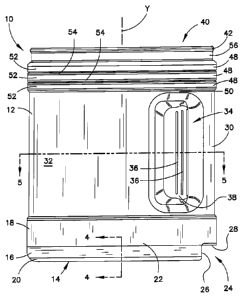Une partie des informations de ce site Web a été fournie par des sources externes. Le gouvernement du Canada n'assume aucune responsabilité concernant la précision, l'actualité ou la fiabilité des informations fournies par les sources externes. Les utilisateurs qui désirent employer cette information devraient consulter directement la source des informations. Le contenu fourni par les sources externes n'est pas assujetti aux exigences sur les langues officielles, la protection des renseignements personnels et l'accessibilité.
L'apparition de différences dans le texte et l'image des Revendications et de l'Abrégé dépend du moment auquel le document est publié. Les textes des Revendications et de l'Abrégé sont affichés :
| (12) Brevet: | (11) CA 2771163 |
|---|---|
| (54) Titre français: | EMBALLAGE DE CANETTE EN PLASTIQUE |
| (54) Titre anglais: | PLASTIC CAN PACKAGE |
| Statut: | Octroyé |
| (51) Classification internationale des brevets (CIB): |
|
|---|---|
| (72) Inventeurs : |
|
| (73) Titulaires : |
|
| (71) Demandeurs : |
|
| (74) Agent: | BERESKIN & PARR LLP/S.E.N.C.R.L.,S.R.L. |
| (74) Co-agent: | |
| (45) Délivré: | 2015-11-03 |
| (86) Date de dépôt PCT: | 2010-09-28 |
| (87) Mise à la disponibilité du public: | 2011-04-14 |
| Requête d'examen: | 2013-01-14 |
| Licence disponible: | S.O. |
| (25) Langue des documents déposés: | Anglais |
| Traité de coopération en matière de brevets (PCT): | Oui |
|---|---|
| (86) Numéro de la demande PCT: | PCT/US2010/050498 |
| (87) Numéro de publication internationale PCT: | WO2011/043956 |
| (85) Entrée nationale: | 2012-02-14 |
| (30) Données de priorité de la demande: | ||||||
|---|---|---|---|---|---|---|
|
L'invention concerne un emballage comprenant un contenant ayant une partie inférieure fermée, une partie supérieure ouverte comportant une collerette s'étendant vers l'extérieur, et un corps ayant un périmètre incorporé généralement cylindrique entourant un axe longitudinal entre la partie inférieure et la partie supérieure. Un opercule peut être scellé à la collerette s'étendant vers l'extérieur pour fermer la partie supérieure ouverte et un bouchon peut être placé sur l'opercule et relié de manière amovible à la collerette s'étendant vers l'extérieur afin de protéger l'opercule, la partie inférieure, la partie supérieure fermée hermétiquement par l'opercule, et le corps définissant ensemble un volume intérieur. Le corps peut comprendre une paire opposée de saillies intérieures s'étendant longitudinalement et formant une poignée saisissable divisant le corps en une surface antérieure d'étiquette occupant au moins 180° du corps et une surface postérieure d'étiquette plus petite que la surface antérieure d'étiquette. Chaque saillie intérieure peut comprendre une pluralité de crêtes longitudinales sur une surface tournée vers l'avant afin de faciliter la saisie de l'emballage avec une seule main. Une pluralité de nervures périphériques peut être située entre l'extrémité supérieure des saillies intérieures et la collerette s'étendant vers l'extérieur pour préserver la forme de l'emballage durant le stockage sur des éléments de rayonnage de produits alimentaires du commerce.
A package includes a container having a closed bottom, an open top having an outwardly extending flange, and a body having an enclosed generally cylindrical perimeter surrounding a longitudinal axis between the bottom and the top. A foil can sealed to the outwardly extending flange to close the open top and a cap positioned over the foil and removably connected to the outwardly extending flange to protect the foil, the bottom, foil sealed top, and body together defining an interior volume. The body can include an opposed pair of longitudinally extending inward protrusions forming a graspable handle dividing the body into a front label surface occupying at least 180° of the body and a back label surface smaller than the front label surface. Each inward protrusion can include a plurality of longitudinal ridges on a forwardly facing surface to facilitate single handed grasping of the package. A plurality of circumferential ribs can be situated between an upper end of the inward protrusions and the outwardly extending flange to preserve the package shape during storage on commercial food storage racks.
Note : Les revendications sont présentées dans la langue officielle dans laquelle elles ont été soumises.
Note : Les descriptions sont présentées dans la langue officielle dans laquelle elles ont été soumises.

Pour une meilleure compréhension de l'état de la demande ou brevet qui figure sur cette page, la rubrique Mise en garde , et les descriptions de Brevet , États administratifs , Taxes périodiques et Historique des paiements devraient être consultées.
| Titre | Date |
|---|---|
| Date de délivrance prévu | 2015-11-03 |
| (86) Date de dépôt PCT | 2010-09-28 |
| (87) Date de publication PCT | 2011-04-14 |
| (85) Entrée nationale | 2012-02-14 |
| Requête d'examen | 2013-01-14 |
| (45) Délivré | 2015-11-03 |
Il n'y a pas d'historique d'abandonnement
Dernier paiement au montant de 263,14 $ a été reçu le 2023-08-09
Montants des taxes pour le maintien en état à venir
| Description | Date | Montant |
|---|---|---|
| Prochain paiement si taxe générale | 2024-09-30 | 347,00 $ |
| Prochain paiement si taxe applicable aux petites entités | 2024-09-30 | 125,00 $ |
Avis : Si le paiement en totalité n'a pas été reçu au plus tard à la date indiquée, une taxe supplémentaire peut être imposée, soit une des taxes suivantes :
Les taxes sur les brevets sont ajustées au 1er janvier de chaque année. Les montants ci-dessus sont les montants actuels s'ils sont reçus au plus tard le 31 décembre de l'année en cours.
Veuillez vous référer à la page web des
taxes sur les brevets
de l'OPIC pour voir tous les montants actuels des taxes.
Les titulaires actuels et antérieures au dossier sont affichés en ordre alphabétique.
| Titulaires actuels au dossier |
|---|
| AMCOR RIGID PLASTICS USA, INC. |
| Titulaires antérieures au dossier |
|---|
| S.O. |